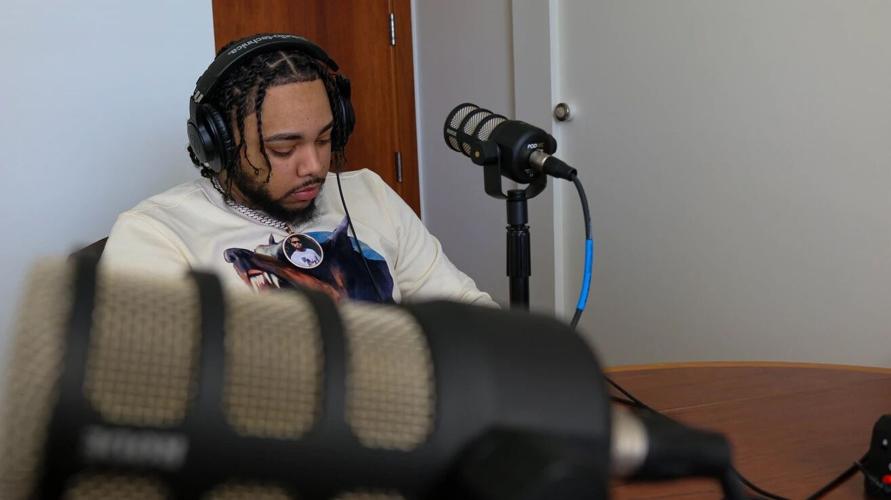Lack Of Affordable Housing And Secure Employment Help Drive Recidivism Rate
- By Thomas Samuel, TheStatehouseFile.com

Robert Jones, 44, poses for a photo at the Indianapolis Central Library. Jones recently got his library card and spends a lot of time there.


Cameron Farris, 26, prepares for his guest appearance on the new podcast “Release Talk.” The podcast highlights incarcerated people who have been released and are doing well now.
The jumping on the bed, followed by the pleas for it to stop as laughter fills the room is a highlight to every child and parent’s morning.
But what happens if the parent is no longer in the bed for their child to jump on? What happens if they won’t be there the next morning or the morning after that?
For Cameron Farris, 26, this was all he could think about as he waited downtown to be processed by the Marion County criminal system right after being arrested. Spending months in jail for possession of a firearm without a license, he couldn’t wait to go back and live those moments again.
Would it be the same, though? Would anything be the same? How would his life be after he missed so much time with his family? Would he be able to get back on his feet, or would he become another lost statistic?
Now Farris is just one of many Hoosiers struggling to rejoin society after being released from 13 months of incarceration. In Indiana, there are about 52,000 people incarcerated, and 18,000 will go back behind bars—around 35%. Two of the biggest challenges they will face are a lack of employment and affordable housing.
How hard is it to truly rejoin society after being released from jail as a felon and why?
According to Justice.gov, people who are convicted of crimes and considered felons are bound by these restrictions: They cannot carry or own a firearm, are not eligible to serve in any armed forces, cannot work in certain occupational fields, are not able to serve on a court jury, cannot vote depending on the state they reside in, are limited as to where they can travel, cannot apply for grants, cannot live in public housing, and cannot receive other government assistance or benefits.
In addition to these restrictions, some of the main things that are needed to survive in today’s world, such as employment and housing, are hard to come by. This can often lead to people falling back into their old ways, eventually leading them to add to the recidivism rate.
According to the Indiana Department of Corrections (IDOC), the recidivism rate for adults returning to the IDOC from 2014 to 2021 was between 33% and 39%. Male offenders had a higher recidivism rate of 38.8%, versus their female counterparts, who had a 22.3% recidivism rate.
Over a third of people who are incarcerated in Indiana will go back to jail within three years of being released.
Farris was part of this group, returning to jail not only once but a second time as well. This is despite the work release and rehabilitation programs that are offered throughout the state. IDOC states that offenders who participated in a work release program were 26.46% less likely to return to prison compared to those who did not.
Farris’ Story
Farris is a 26-year-old Indianapolis native. He grew up in a single-parent household with his mother and two sisters. From a young age, Farris was forced to grow up faster than most children. Due to financial struggles that his family faced most of his childhood, he tried to make money on the “streets.†From the time he was a teenager, he had fully committed to this lifestyle, selling drugs and more, which later led to him being incarcerated three separate times.
Indiana Sen. Greg Taylor, D-Indianapolis, sits on the Indiana General Assembly’s Corrections and Criminal Law Committee. He said, “IDOC has many programs that help with re-entry, but they are far too few and far between to be really effective.â€
Taylor said that IDOC leans more toward punishment than rehab, so the main problem is the lack of funding that these programs receive.
Despite the lack of state funding, there are still successful rehabilitation programs throughout the state. One of these is Churches Embracing Offenders (CEO). Westin Leach, director of the Vanderburgh County CEO branch, said that the organization is “dedicated to serving the physical, social, emotional, and spiritual needs of people who are re-entering the community.â€
Leach explained that in the first few hours after release, people in his program are pretty sure they will have a job in a couple of days, they know where they are going to sleep, they are set up to go to a clothing and food bank, and they are given referrals to free clinics for medical care. After all of this is done, he said you can see people relax a little because all of these barriers have been knocked down.
While in the program, participants must go to church once a week, attend 12-step recovery once a week, meet with their mentor (who is also part of their church) once a week, stay substance-free, complete a 10-week course on cognitive behavioral therapy, and refrain from breaking the law.
Leach stated that even after graduating from the program, many participants stay involved. “It becomes a part of their life,†he said.
Unfortunately, it is not that simple for everyone recently released from incarceration. Many people don’t have access to these programs and are forced to deal with the struggles themselves, oftentimes having trouble overcoming them. Many people have a negative opinion toward felons, and it causes a lot of difficulties when trying to get hired at a job.
“Society also imposes a stigma on felons. It’s a natural reaction, but it’s important to recognize forgiveness as a society because the alternative is recidivism in an individual, and we certainly don’t want that,†Taylor said. “And when I mention forgiveness, I mean in societal terms, not the victim’s forgiveness.â€
Employment
“I could find jobs, just not the ones that I wanted,†Farris said. “The pay wasn’t enough to support my needs or my family’s.â€
He said he felt like he couldn’t get any “good jobs” due to the fact that he had a criminal record. According to thelawdictionary, Indiana is a state that allows employers to ask you about your criminal history on applications as well as make hiring decisions based on that information. Employers are also not required to disclose their reason for not hiring an applicant.
“All of the jobs that were paying good wouldn’t take me as soon as they found out I had a felony,†Farris said.
Taylor has recently tried to combat the issue of employers not giving released felons a second chance by eliminating what shows up on their background checks, and providing opportunities for expungement.
According to a study done over the last 12 years by The Prison Policy Initiative, of 51,000 people who were released from prison, 62% were unemployed after six months, 63% were unemployed after one year, and 65% were unemployed after four years. That’s compared to during the COVID-19 pandemic when the country reached its peak unemployment of just 15%.
There is also a large disparity in the wages people who were formerly incarcerated make versus those who weren’t. The Prison Policy Initiative conducted a study that showed that people who were incarcerated are making on average almost $240 less per week during the same year they were released than those who were not incarcerated. After a four-year period, people who were formerly incarcerated were still making roughly $100 less than their counterparts.
“I’ve passed several bills opening up expungement for nonviolent crimes committed years before the application for the expungement if the felon had clearly demonstrated rehabilitation and good citizenship. This has already been a boon for those looking to move forward with their life,†Taylor said.
Not all employers are opposed to second chances. There are still a large number of companies and employers who offer the same opportunities to felons as they do to those who have no criminal background at all.
“We don’t hold their background at all against them. We hire people who are straight out of prison, in work release, or straight out of drug and alcohol treatment,†said Melanie Harrison, Evansville Packaging Supply’s HR manager.
Harrison said that she has seen a lot of people who just needed a second chance end up doing well, all because they were given an opportunity. Many of them have graduated from their work release or rehabilitation programs and are still employed with the company.
She stated that the company has been hiring released and recovering people for years, and they have essentially been the backbone of the company since.
Others have found luck on their own with second-chance employers all over the state. One of them is Robert Jones, 44, who was released two years ago after spending 13 years in federal prison.
Jones spent his time in prison reading books and getting his forklift certification. He also made sure that all of the documents he needed to get a job were in order prior to his release.
“You have to be prepared from Day 1. Nothing can be missing. You gotta have everything ready so they can’t find any excuses to not hire you because trust me, if you give them a reason to, they won’t hire you, and then you just lost a hard-to-come-by opportunity,†Jones said.
He also said that there are not a lot of chances out there for people with his background, so he knew he needed to make the most of every opportunity. He is now hired at a regional shipping company and enjoys working there. Jones said that the job has given him a new purpose in life and gives him something to look forward to.
“I was really blessed and fortunate to have a place to go when I got out,†Jones said. “My grandmother left the property, so I don’t have any crazy-high rent or have to deal with housing applications.
“I know not everyone is as lucky as I am, though.â€
Housing
Many people are not as fortunate and struggle with finding safe and secure housing. This is partially due to the restrictions on assistance for felons. Thelawdictionary.org highlighted that the Fair Housing Act does not protect against discrimination from landlords regarding criminal background like it does race, color, national origin, religion, sex, familial status and disability.
A case study by the Prison Policy Initiative found that formerly incarcerated people were homeless at a much higher rate than those who had not been incarcerated. Of a 10,000-person pool, those who had not spent time in jail were seven times less likely to be homeless than those who were incarcerated one time and 13 times less likely to be homeless than those who were incarcerated more than once.
“I kept applying, but I didn’t have any luck. I knew it was because of my background even though I was never given a reason. Eventually, I had to figure something out, so I ended up staying with family,†Farris said.
This is the case for many people who are released from incarceration. There are not that many feasible housing opportunities for them when they get out. Yes, there are options, but they are limited and oftentimes completely full. According to the National Low Income Housing Coalition (NLIHC), 27% of renters are extremely low income (ELI). There is a shortage of 135,000 affordable and available homes for ELI in Indiana and a 72% rate of ELI households for which rent is a severe cost burden. This can cause a constant stress in their lives, and this stress can cause people who have a criminal history to revert back to a life of crime, adding to the cycle of recidivism.
Nevertheless, Farris said, “I don’t ever plan on going back. I’m doing things the right way.â€
He recently joined a program that teaches convicted felons trades and sets them up with a career path, something that he has been looking to do for a long time now. He has decided to learn welding and hopes to master it and learn another trade with the hope to eventually start his own business, offering other people in his situation a second chance.
Farris spends most of his free time now enjoying the little moments in life with his family—including being jumped on before the sun rises every morning. His son has recently joined a basketball league, and Farris spends time playing and practicing with him. His two daughters are both ballerinas, and he is looking forward to their first recital.
To him, family is everything, and he plans to be around for every moment in the future.





